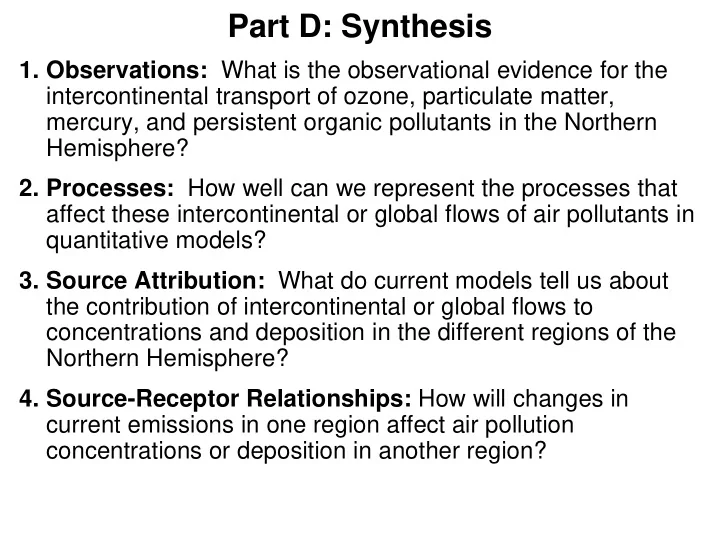

Part D: Synthesis 1. Observations: What is the observational evidence for the intercontinental transport of ozone, particulate matter, mercury, and persistent organic pollutants in the Northern Hemisphere? 2. Processes: How well can we represent the processes that affect these intercontinental or global flows of air pollutants in quantitative models? 3. Source Attribution: What do current models tell us about the contribution of intercontinental or global flows to concentrations and deposition in the different regions of the Northern Hemisphere? 4. Source-Receptor Relationships: How will changes in current emissions in one region affect air pollution concentrations or deposition in another region?
Part D: Synthesis 5. Impacts: What is the contribution of these intercontinental or global flows to impacts on human health, natural and agricultural ecosystems, and near-term climate change? 6. Future Scenarios: How may the source-receptor relationships change over the next 20 to 50 years due to changes in emissions and climate change? 7. International Cooperation: Is international cooperation on intercontinental or global scales warranted to address these pollutant flows? 8. Future Science Directions: What efforts are needed to develop an integrated system of observation data, emissions, and models to better understand and track these flows?
1. Observations: What is the observational evidence for the intercontinental transport of ozone, particulate matter, mercury, and persistent organic pollutants in the Northern Hemisphere? – Events/Plumes – Satellite Observations – Trends in Remote Locations (and comparison to emission trends)
2. Processes : How well can we represent the processes that affect these intercontinental or global flows of air pollutants in quantitative models? – Ability to represent overall patterns based on existing models, emissions, and observations. – Challenges for modeling intercontinental flows – Relative levels of confidence O3 > PM > Hg > POPs?
3.Source Attribution: What do current models tell us about the contribution of intercontinental or global flows to concentrations and deposition in the different regions of the Northern Hemisphere? O3 PM Hg POPs Inside Region Inside Region Inside Region Inside Region NOx/VOC/CO Anthro PM & New Anthro New Emissions Precursors Emissions Outside Region Outside Region Outside Region Outside Region NOx/VOC/CO Anthro PM & New Anthro New Emissions Precursors Emissions Methane Vegetation Burning Re-Emission Re-Emission Natural Dust/Sea Salt/ Natural Volcanoes Each fraction has different implications for controllability, sensitivity to emission changes, seasonality, spatial variability, …
4. Source-Receptor Relationships: How will changes in current emissions in one region affect air pollution concentrations or deposition in another region? – Relative Strength of S/R Pairs • O3: NA to EU • Hg: EA – Import Sensitivity (combined effect of outside region on inside region)
5. Impacts: What is the contribution of these intercontinental or global flows to impacts on human health, natural and agricultural ecosystems, and near-term climate change? • By pollutant? Separate section for Arctic? • Different types of information for different pollutants • Emphasize multiple benefits, shared benefits
6. Future Scenarios: How may the source- receptor relationships change over the next 20 to 50 years due to changes in emissions and climate change? – Expected impacts of emission changes – Potential impacts of expected climate change.
7. International Cooperation: Is international cooperation on intercontinental or global scales warranted to address these pollutant flows? – Inability to meet some policy goals if intercontinental flows are not mitigated. – Shared benefits of emission control: • Direct: Health, Ecosystem, Climate • Indirect: Avoided Costs of Control – Costs and availability of controls needs to be investigated further. – Control Decisions need to be understood in terms of their local, regional, and global impacts.
8. Future Science Directions: What efforts are needed to develop an integrated system of observation data, emissions, and models to better understand and track these flows? – Can’t include all recommendations – Focus on common themes and recommendations that cut across disciplines? – Try to highlight cost effective investments? – Role for TF HTAP?
Recommend
More recommend